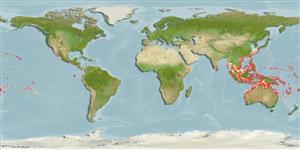Classification / Names
Common names from other countries
Main reference
Size / Weight / Age
Max length : 19.0 cm TL male/unsexed; (Ref. 9710); max. reported age: 6 years (Ref. 11318)
Environment
Marine; reef-associated; non-migratory; depth range 4 - 55 m (Ref. 30874)
Climate / Range
Tropical, preferred ?; 32°N - 32°S
Distribution
Western Pacific: Christmas Island in the eastern Indian Ocean to Fiji, north to southern Japan, south to Scott Reef (eastern Indian Ocean) and Lord Howe Island. Uncommon around oceanic islands (Ref. 9710).
Countries | FAO areas | Ecosystems | Occurrences | Introductions
Short description
Dorsal
spines
(total): 14;
Dorsal
soft rays
(total): 15-16;
Anal
spines: 3;
Anal
soft rays: 16 - 17. Overall black with an elongate vertical black blotch on the middle of the upper sides. When small, mainly black with a white bar; the white bar changes to a central blotch and varies greatly in shape and size (Ref. 48636). Dorsal and anal fins with submarginal blue line; most of the pelvic and the anterior portion of the anal fin yellow. Caudal fin with submarginal blue line (Ref. 1602). Body depth 1.8-2.0 in SL. Scales longitudinal series 45-48 (Ref. 90102).
IUCN Red List Status (Ref. 115185)
Threat to humans
Harmless
Human uses
Aquarium: commercial
More information
ReferencesAquacultureAquaculture profileStrainsGeneticsAllele frequenciesHeritabilityDiseasesProcessingMass conversion
Tools
Special reports
Download XML
Internet sources
Estimates of some properties based on models
Phylogenetic diversity index
PD50 = 0.5000 many relatives (e.g. carps) 0.5 - 2.0 few relatives (e.g. lungfishes)
Trophic Level
2.8 ±0.35 se; Based on food items.
Resilience
High, minimum population doubling time less than 15 months (Preliminary K or Fecundity.)
Vulnerability
Low to moderate vulnerability (26 of 100)
Price category
